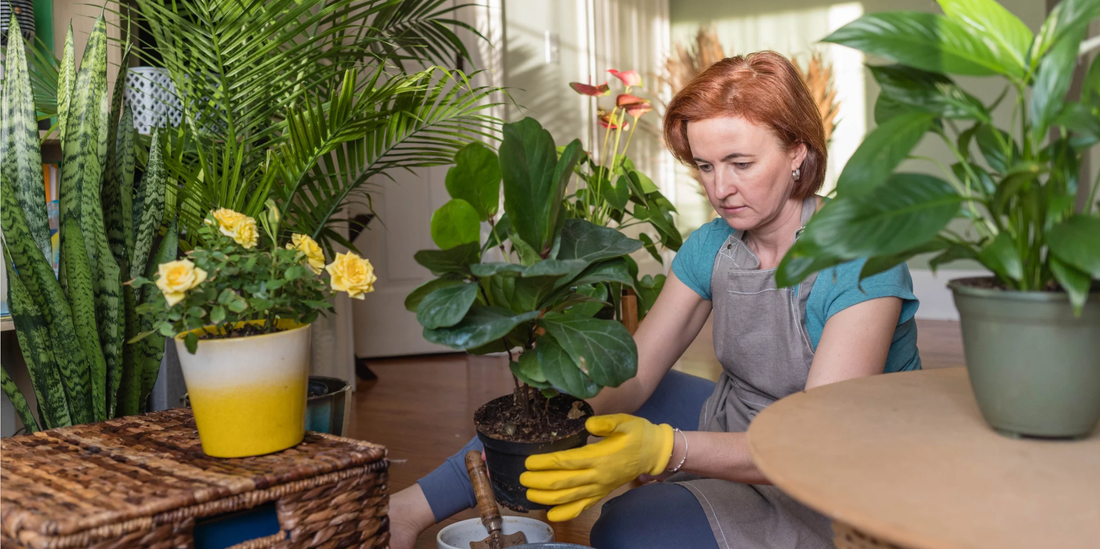Give your plants a fresh start with healthy roots, right soil, and confident care.
Why This Guide Matters
If you’ve ever wondered “When should I repot my houseplant?” or “How do I avoid root rot after repotting?”, you’re in the right place. Repotting is one of those plant-care tasks that’s simple in concept but easy to get wrong — which can stress your plant, slow growth, or even cause damage.
This post will walk you through the process, explain why each step matters, and link you to the right products to make sure your tropical houseplants thrive.
1. Signs it’s time to repot
Look for these indicators:
-
Roots are circling inside the pot or coming out of drainage holes.
-
Soil no longer drains well, and water sits for a long time.
-
Plant growth has slowed, or you see yellowing/leaves dropping (when you know water/light are OK).
-
It’s been roughly 12-18 months for many fast-growing tropicals.
Best time to repot: typically in spring or early summer, when the plant is actively growing. Avoid heavy flowering, dormancy (late fall/winter), or very stressed plants.
2. Gather your supplies
Before you dive in, have everything ready:
-
A new pot with drainage holes (1-2 inches larger diameter for small/medium plants; don’t oversize).
-
Fresh potting mix optimized for tropical houseplants. At Urbane Eight you have excellent options: Maya’s Growing Mediums blends (e.g., Aroid Mix, General Mix) are formulated for good drainage + moisture retention.
-
Tools: gardening gloves, small trowel or scoop, clean pruners/scissors, maybe a tray or newspaper to catch soil.
-
Watering can / spray bottle, maybe support stakes/moss poles (especially for climbers) if needed.
-
Optionally, root-friendly amendments: beneficial microbes, mild fertilizer after recovery, etc. For example: Bios Plant Probiotics helps with root health and soil disease suppression.
3. Choose the right pot & soil combination
-
Pot material & drainage: Terracotta (breathable but dries faster), plastic (lighter and retains moisture), glazed ceramic — all fine if drainage is good.
-
Size: Don’t go too big. A much larger pot means too much soil relative to roots → wet spots, risk of root rot. 1-2″ larger is good.
-
Soil / growing medium: Tropical houseplants do best in well-aerated, well-draining mixes that still retain sufficient moisture. Chunky ingredients (bark, coco chunks, perlite, charcoal) help.
-
Product plug: For example, using Maya’s Aroid Mix or Maya’s General Potting Mix means you’re giving your plant a substrate built for tropical root systems. (Peat-free, good aeration)
4. The repotting process — step by step
Step 1: Water your plant a day before
Watering the day before helps loosen the soil and reduce root damage when you remove the root ball.
Step 2: Remove the plant gently
-
Tilt the pot sideways, gently coax out the plant by tapping or squeezing (for plastic).
-
Avoid pulling on the stems/leaves. If the plant is stubborn, use a flat tool to loosen soil around edges. l
Step 3: Inspect & loosen roots
-
Look for root-bound conditions (roots circling, tangling). Loosen gently.
-
Trim any rotted roots (dark, mushy, foul smell) or obviously unhealthy sections.
Step 4: Place plant in new pot + fill soil
-
Add a base layer of fresh potting mix so plant sits at roughly same depth as before.
-
Place plant, fill around root ball with mix — don’t pack too tightly, but firm lightly to remove major air pockets.
-
Leave a bit of space at top of pot (so when you water, soil doesn’t spill over).
Step 5: Water thoroughly
-
Water until you see drainage flow out. This helps settle soil around roots.
-
After watering, avoid heavy direct sunlight for a few days, reduce stress while plant recovers.
Step 6: Aftercare
-
Keep soil moderately moist, don’t overwater. Newly repotted plants are vulnerable to root rot or shock.
-
Don’t fertilize immediately if soil is fresh/enriched — often wait 4-6 weeks before full feeding.
-
Monitor for signs of distress (wilting, yellowing, slowed growth) and adjust location, watering accordingly.
5. Common mistakes & how to avoid them
-
Pot too big → too much soil, stays soggy → root rot.
-
Poor drainage / no drainage holes → fatal for many tropicals.
-
Using generic “outdoor soil” which may compact or retain too much water.
-
Repotting at wrong time (e.g., deep winter dormancy).
-
Overwatering immediately after repotting before plant has adjusted.
-
Neglecting aftercare: light, humidity, airflow matter.
Want to watch how it’s done?
Check out this helpful video below showing a full repotting demo for tropical houseplants: Click to Watch
Final Thoughts
Repotting doesn’t have to be scary. With the right timing, materials, and care, you’re giving your plants one of their best opportunities for strong growth and long-term health. And at Urbane Eight, your plants can get everything they need: from the right soils (Maya’s mixes), to root health boosters (Bios Probiotics), to expert advice.




